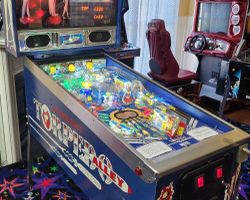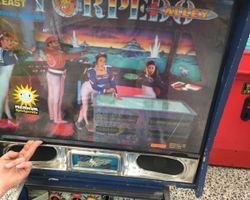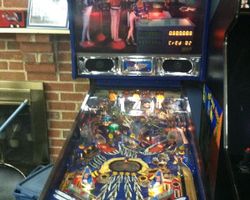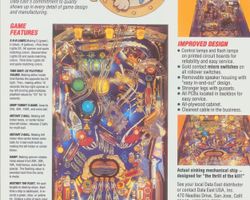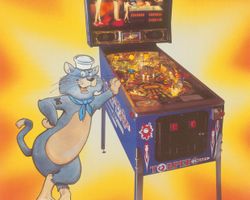Torpedo Alley
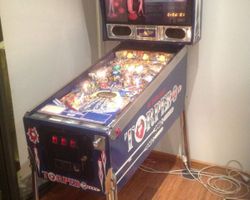
Average Prices: USD $200 to $2,000
Produced: August, 1988
Production Run: 1,002 units
Machine Type: Solid State Electronic
MPU: DataEast/Sega Version 2
Players: 4
Design by: Claude Fernandez
Art by: Kevin OConnor, Margaret Hudson, Kevin O'Connor
Music by: David Thiel
Sound by: David Thiel, Kyle Johnson
Software by: Lonnie D. Ropp, Richard Ditton
"Torpedo Alley," a submarine-themed pinball machine from Data East, surfaced in the pinball landscape in early 1988, with production running from August to November of that year. It emerged as a distinctive title, offering players an immersive journey into underwater combat. Data East USA, Inc., the manufacturer, had a vision for a machine that combined engaging gameplay with innovative technology for its time.
The machine's design was a collaborative effort. Claude Fernandez was the primary designer, responsible for crafting the playfield layout and gameplay experience. The striking visual identity of "Torpedo Alley" was brought to life by artists Kevin O'Connor and Margaret Hudson, who imbued the machine with a vibrant, albeit often described as "cheesy," 1980s aesthetic. David Thiel contributed significantly to the auditory experience, composing the music and much of the sound design, with Kyle Johnson also providing sound work. Software development was handled by Lonnie D. Ropp and Richard Ditton, ensuring the rules and modes functioned seamlessly. "Torpedo Alley" marked several notable milestones. With only 1,002 units produced, it became a relatively rare machine, particularly in the United States, where only an estimated 200 units remained, the rest being shipped overseas. It stood out as one of the earliest solid-state electronic (SS) games to feature full stereo sound, a significant advancement for pinball audio. Furthermore, "Torpedo Alley" pioneered the "buy-in" feature, allowing players to insert additional coins to retain their progress for the next game—an operator-optional feature that extended gameplay for those seeking to chase high scores.
Signature Features and Design
"Torpedo Alley" is defined by several standout elements that contribute to its distinctive identity and play experience. The most visually arresting of these is its double-layered, photographic backglass, creating a unique 3D effect. This dimensional quality provided a depth not commonly seen on pinball backglasses of the era, drawing players into the machine's underwater world even before plunging the ball. While its artistic style has often been debated for its 80s camp, the 3D aspect is consistently highlighted as a notable design achievement.
On the playfield, a central and captivating feature is the "sinking ship" mechanism. Positioned beneath a periscope-like glass, this miniature ship toy physically lowers into the playfield, simulating a vessel going down after being hit. This animation is triggered by hitting specific ship targets on the playfield, providing immediate visual feedback and enhancing the combat theme. The integration of this mechanical toy with the target system created a tangible sense of accomplishment for players.
Beyond these visual elements, the machine's commitment to immersive audio was a hallmark. "Torpedo Alley" was among the first Data East games to fully embrace stereo sound, delivering a richer and more dynamic soundscape than typical monaural setups. This enhanced the atmospheric music and varied sound effects, immersing players further into the submarine warfare theme. The inclusion of a left outlane kickback and two "torpedo tube" kickouts further integrated the theme into mechanical play, offering players opportunities to save their ball or launch it with purpose, replicating the feeling of launching a torpedo.
Playfield and Mechanics
The playfield layout of "Torpedo Alley" is designed for a combination of strategic shots and fast-paced action. It features a three-flipper arrangement, including a crucial upper right flipper that is essential for reaching specific targets and ramps on the upper playfield. The main playing area is populated by three pop bumpers and two slingshots, ensuring lively ball movement in the lower half of the playfield.
Two wireform ramps dominate the upper playfield, providing distinct shot opportunities. These ramps are integral to progressing through objectives and accumulating points. Three drop targets, often forming part of the "fleet" to be destroyed, add another layer of challenge and skill. A spinner target, a classic pinball element, provides satisfying rapid scoring when hit with force. The overall flow of the playfield is designed to encourage players to utilize the entire layout, from precise ramp shots to aggressive pop bumper action. The upper right flipper is not merely an auxiliary flipper; it is often required for critical shots to advance game modes, creating a unique rhythm to gameplay that distinguishes it from many other machines.
Visually, the playfield artwork by Kevin O'Connor and Margaret Hudson reinforces the submarine and ocean combat theme. Detailed illustrations of submarines, ships, and underwater environments cover the surface. The lighting system, particularly the general illumination flashers, contributes significantly to the playfield's aesthetic. These flashers are utilized to create dramatic light shows, especially during high-scoring events like multiball, intensifying the gameplay experience and guiding the player's attention to key areas. The animated sinking ship beneath its periscope glass provides a dynamic focal point, reinforcing the core theme during active gameplay.
Gameplay Dynamics
"Torpedo Alley" offers a straightforward yet engaging gameplay experience centered around the objective of destroying an enemy fleet. The primary progression involves hitting specific targets representing enemy ships, often leading to the activation of the notable "sinking ship" animation on the playfield. As players destroy more ships, they advance towards higher-value targets and objectives.
The scoring system is progressive, with successful shots and mode completions building towards a lucrative jackpot. This escalating reward structure encourages repeated engagement with the machine's core mechanics. One of the game's highlights is its three-ball multiball, which is readily accessible and highly rewarding. Initiating multiball is often described as a "blast," characterized by an impressive light show and dynamic sound effects that punctuate the action. The instant multiball feature (allowing for either two or three balls) provides quick bursts of high-scoring opportunity.
Unique to "Torpedo Alley" for its time was the "buy-in" feature. If enabled by the operator, this allowed players to insert additional coins after their game ended to retain certain playfield achievements and continue from a more advantageous position in the next game. This strategic option offered a novel way for players to extend their enjoyment and chase higher scores or complete objectives they were close to achieving. Player strategies often revolve around mastering the shots to the ramps and the drop targets, as these are crucial for building towards multiball and the progressive jackpot. Utilizing the upper right flipper effectively is essential for precision shots and controlling the ball's flow in the upper playfield. The game's sound and music cues are also vital, guiding players to jackpot opportunities or indicating activated modes, making the auditory feedback an integral part of the gameplay strategy.
Reception and Legacy
Upon its release and in the years since, "Torpedo Alley" has garnered a largely positive reception within the pinball community, often described as an "underrated gem." Its strengths frequently center on its immersive and innovative technical features for the era. The music and sound package, notably its full stereo capabilities, are consistently praised. Players often highlight the variety of tracks, the way music cues key gameplay events, and the humorous and thematic callouts, contributing to an overall auditory experience that many consider excellent for the late 1980s.
The light show and alphanumeric display animations are also frequently lauded. The coordinated flashing of general illumination lights during multiball and other significant events, combined with the detailed animations on the alphanumeric display, created a dynamic and engaging visual presentation that was considered advanced for its time. From a gameplay perspective, "Torpedo Alley" is generally perceived as fun, addictive, and possessing good replayability. Its accessible nature appeals to casual players, while the unique playfield layout, particularly the necessity of the upper right flipper, offers enough depth to keep more experienced players engaged. The multiball sequence, in particular, is noted as a rewarding and exciting experience due to its visual and auditory impact. While the "cheesy" 80s theme and the 3D photographic backglass can be polarizing, many players find its campy charm contributes to the game's distinct appeal and sense of fun. Its value proposition is also frequently mentioned, with many considering it an excellent "bang for your buck" in the collector's market.
However, "Torpedo Alley" is not without its criticisms. The backglass, despite its 3D effect, is sometimes cited as a visual weakness by those who do not appreciate its 80s aesthetic. Maintenance and durability concerns are occasionally raised; some units reportedly suffer from airballs, and certain plastics (like the "mountains") can show wear. Aligning the plunger ramp shot can also be challenging on some machines. A few players have noted that certain close-up shots can be dangerous, leading to quick drains, which can make the game feel like a "quarter-eater" to some. Additionally, while generally praised for its depth, a minority opinion suggests the rule set is not as intricate as some later machines, although this is often balanced by the sheer fun factor.
Despite these minor points, "Torpedo Alley" has carved out a respectable legacy. Its low production numbers, especially in the US, contribute to its rarity and make it a sought-after machine for some collectors. It stands as an example of Data East's early efforts to push technological boundaries, specifically with its implementation of stereo sound and the "buy-in" feature. The animated sinking ship and the layered backglass further highlight an era of experimentation and creativity in pinball design. "Torpedo Alley" endures as a celebrated example of late 1980s pinball, a machine that often surprises those who play it for the first time, proving its sustained appeal and solid design.
Sponsored Links
 Ebay Listings
Ebay Listings
 Auction Results
Auction Results
| Cost | Location | Date |
|---|---|---|
| USD $6,000 |  Tennessee, United States Tennessee, United States |
12 September, 2024 |
| USD $2,500 |  Pennsylvania, United States Pennsylvania, United States |
18 June, 2023 |
| USD $3,800 |  Illinois, United States Illinois, United States |
16 September, 2021 |
| USD $2,800 |  South Carolina, United States South Carolina, United States |
01 September, 2021 |
| USD $2,300 |  Pennsylvania, United States Pennsylvania, United States |
17 April, 2021 |
| USD $1,600 |  Illinois, United States Illinois, United States |
31 August, 2017 |
| USD $1,600 |  Missouri, United States Missouri, United States |
16 November, 2016 |
| AUD $837 |  Victoria, Australia Victoria, Australia |
14 August, 2015 |
| AUD $1,650 |  Victoria, Australia Victoria, Australia |
12 May, 2014 |
| USD $518 |  Ohio, United States Ohio, United States |
11 January, 2012 |


Private Policy · Search Website · Contact Us
As an eBay Partner, we may earn a commission from qualifying purchases made through links on this site, at no additional cost to you.
All trademarks and copyrighted materials remain property of their respective owners. All other content copyright 2007 - 2025 Pinpedia.

